Dynamic routing and wavelength assignment algorithm of optical satellite networks based on cross-layer design①
2017-09-25WenGuoli文国莉ZhangQiTianQinghuaWangHoutianTaoYingChenDongLiuNaijinShenYufeiZhouNa
Wen Guoli (文国莉), Zhang Qi, Tian Qinghua, Wang Houtian, Tao Ying,Chen Dong, Liu Naijin, Shen Yufei, Zhou Na
(*School of Electronic Engineering, Beijing University of Posts and Telecommunications, Beijing 100876, P.R.China)(**China Academy of Space Technology, Beijing 100094, P.R.China)
Dynamic routing and wavelength assignment algorithm of optical satellite networks based on cross-layer design①
Wen Guoli (文国莉)*, Zhang Qi②*, Tian Qinghua*, Wang Houtian**, Tao Ying**,Chen Dong**, Liu Naijin**, Shen Yufei**, Zhou Na**
(*School of Electronic Engineering, Beijing University of Posts and Telecommunications, Beijing 100876, P.R.China)(**China Academy of Space Technology, Beijing 100094, P.R.China)
In order to overcome the adverse effects of Doppler wavelength shift on data transmission in the optical satellite networks, a dynamic routing and wavelength assignment algorithm based on cross-layer design (CL-DRWA) is introduced which can improve robustness of the network. Above all, a cross-layer optimization model is designed, which considers transmission delay and wavelength-continuity constraint, as well as Doppler wavelength shift. Then CL-DRWA is applied to solve this model, resulting in finding an optimal light path satisfying the above constraints for every connection request. In CL-DRWA, Bellman-Ford method is used to find an optimal route and a distributed relative capacity loss method is implemented to get an optimal wavelength assignment result on the optimal route. Moreover, compared with the dynamic routing and wavelength assignment algorithm based on minimum delay strategy (MD-DRWA), CL-DRWA can make an improvement of 5.3% on the communication success probability. Meanwhile, CL-DRWA can meet the requirement of transmission delay for real-time services.
cross-layer design, Doppler wavelength shift, dynamic routing and wavelength assignment, optical satellite network
0 Introduction
Driven by data traffic demand (especially Internet) and successes of laboratory, atmosphere, and space demonstrations of free-space optical communications, there is no doubt that free-space optical communication will be a key building block for wide-area space backbone networks of the future[1-3]. Optical satellite networks offer many potential advantages compared to radio frequency (RF) satellite networks, including a very wide bandwidth, unlicensed spectrum, no need for frequency allocation, security, and resistance to jamming[4-6], which makes them attractive for both civil and military applications. Furthermore, optical networking techniques based on wavelength division multiplexing (WDM) can not only simplify routing decisions but also minimize processing delays, and it is important that the technologies to be employed on board the satellites have to be space-qualified[1,3,7]. The routing and wavelength assignment (RWA) problem, especially under the wavelength-continuity constraint, is the most challenging issue in the wavelength-routed optical satellite WDM networks[8].
RWA problem is proved to be nondeterministic-polynomial-hard (NP-hard)[9]and some methods have been carried out on the RWA problem in optical satellite networks. Using the minimum delay (MD) cost strategy, the fixed-alternate routing method and the first-fit (FF) wavelength assignment method is proposed to estimate the bounds of wavelength requirements in the optical transport networks over nongeosychronous satellite constellations[3,10]. An algorithm with multi-hop grooming and waveplane-based RWA for IP over WDM optical satellite networks is raised, and the costs used for searching a route are physical distance and routing hops respectively[11]. Based on subcarrier layered-graph (SLG), a novel dynamic routing and wavelength/subcarrier assignment (RWSA) algorithm is put forward to find the shortest path with limited costs in the corresponding layered-graph[12]. A perfect match model-based link assignment scheme (LAS-PMM) is introduced to design an appropriate topology such that shorter path could be routed and less wavelengths could be assigned for each inter-satellite link (ISL) along the path[13].
Although the methods mentioned above can provide better solutions from different aspects, there are still problems when significant Doppler is observed by the onboard terminals on the inter-satellite links (ISLs). As a matter of fact, the relatively rapid movement between each pair of establishing ISL satellites in the constellations can cause inevitabl Doppler shift to the signal wavelengths[14]. Furthermore, Doppler wavelength shift leads to ascending of crosstalk power and descending of signal power which directly makes bit error rate (BER) increased[15]. Therefore, in order to overcome the adverse effects of Doppler wavelength shift on data transmission in the optical satellite network, a cross-layer optimization model is established, which takes into account transmission delay, wavelength-continuity constraint and Doppler wavelength shift simultaneously. The solution of the cross-layer optimization model is to select an optimal route and assign an available wavelength in setting up a lightpath for every source-to-destination connection request. For the sake of adapting to the dynamic changes of satellite networks, a dynamic routing and wavelength assignment algorithm based on cross-layer design (CL-DRWA) is used to solve the cross-layer optimization model. In CL-DRWA, Bellman-Ford (BF) algorithm is carried out to find an optimal route from the source to the destination using the transmission delay and Doppler wavelength shift information, which is suitable for satellite networks[16]. And then a distributed relative capacity loss (DRCL) algorithm is implemented to get an optimal wavelength assignment result on the optimal route for the source-to-destication connection request, which can reduce the calculation upon receiving the connection request and have a good performance on blocking probability[9].
The remainder of this paper is organized as follows. Section 1 presents a system architecture and theoretical model for dynamic RWA in optical satellite networks, while Section 2 describes the mechanism of CL-DRWA in detail. Section 3 is devoted to the analysis of CL-DRWA through extensive simulations, and finally, Section 4 summarizes the main conclusions of the paper.
1 System architecture and theoretical model
1.1 System architecture
The system architecture of this paper is shown in Fig.1.
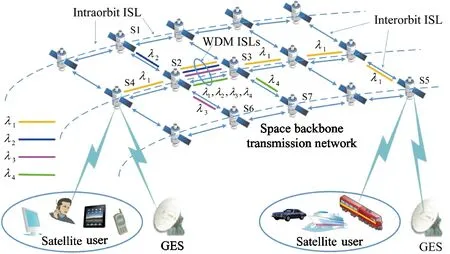
Fig.1 The system architecture
As shown in Fig.1, the system architecture consists of the space backbone transmission network, the gateway earth station (GES) and the satellite user. The space backbone network is formed by a Walker constellation with optical ISLs, which can achieve a global space-based communication service. Walker constellation can be expressed as θ:N/P/F[17], where θ is the inclination of orbital plane, N is the total number of satellites, P is the number of orbital planes and each orbit consists of S satellites, F is the phasing factor. There are two types of ISLs for the network connectivity: intraorbit ISLs and interorbit ISLs. The former interconnects satellites belonging to the same orbit, and the latter interconnects satellites belonging to different orbits. Since the relative distance of two intraorbit ISL satellites are fixed, no Doppler shift can be detected. However, as the relative distance between two interorbit ISL satellites varies from moment to moment, the Doppler wavelength shift is assignable. On the assumption that WDM architectures with wavelength routing are available for the ISL and there is no wavelength converter in the intermediate nodes, a light path should be set up under the wavelength-continuity constraint.
1.2 Theoretical model
The cross-layer optimization can integrate layers of the protocol stack into a comprehensive classification framework, which can improve the performance of the satellite networks[18]. In CL-DRWA, the architecture of cross-layer design for dynamic RWA under the wavelength-continuity constraint in optical satellite networks is illustrated in Fig.2. It is comprised of two main parts: quality of service (QoS) requirements for applications, and cross-layer optimization model.
As shown in Fig.2, transmission delay and BER are two important factors of the QoS requirements for applications[19]. In order to satisfy the QoS requirements for applications, a cross-layer optimization model is established. That is, the physical layer provides transmission delay, wavelength usage and Doppler wavelength shift information to a shared database, while the network layer gets the three kinds of information in the shared database[20]. Then the network layer implements CL-DRWA algorithm to select a route and assign a wavelength in setting up a lightpath for every source-to-destination connection request. Next, the physical layer uses the optimum route and wavelength assignment information to accomplish the switching configuration. Eventually, the data is transmitted and switched. The schematic diagram of CL-DRWA algorithm is presented in Fig.3. It can be seen that CL-DRWA algorithm mainly consists of two parts: BF algorithm and DRCL algorithm. BF is implemented periodically to update the routing table by using the transmission delay and Doppler wavelength shift information, which can provide an optimal route from the source to the destination. And DRCL is carried out cyclically to renew the relative capacity loss (RCL) table using the route information in the routing table and the wavelength usage information, which can get an optimal wavelength assignment result on the optimal route for the source-to-destination connection request.
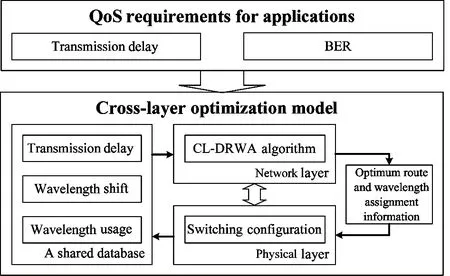
Fig.2 The architecture of cross-layer design for dynamic RWA

Fig.3 The schematic diagram of CL-DRWA algorithm
Suppose P(s,d) is a light path from satellite s to satellite d. i and j denote two interconnecting satellites on P(s,d). linkijmeans optical ISL from i to j, costij(t) is the cost of linkijat moment t. TDij(t) indicates the transmission delay from i to j at moment t. BERij(t) is the BER when the packet passes through linkijat moment t. TDthand BERthrepresent the transmission delay threshold and the BER threshold in the optical satellite network respectively. wij(t) is the wavelength used on linkijof P(s,d) at moment t. Ω={w1,…,wW} is the wavelength resource on each ISL and W is the total number of wavelength candidates in the network. wk∈Ω is the wavelength assigned at the beginning of establishing P(s,d). An ISL is assigned to a source-destination satellite connection based on minimizing the total cost of the specific route. And the specific route should satisfy the constraints of the transmission delay, wavelength-continuity as well as Doppler wavelength shift. Therefore, the cross-layer optimization model proposed in this paper is represented by


(1)

The cost is the weighted sum of transmission delay and Doppler wavelength shift from i to j. So costij(t) can be expressed as
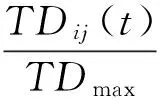
ωd+ωw=1
(2)
where, ωdand ωware the weights for transmission delay and Doppler wavelength shift respectively. TDmaxand |Δλmax| are the maximum transmission delay and the maximum Doppler shift of the optical ISLs in the whole network respectively. |Δλij(t)| can be calculated according to formulas in Ref.[14]. TDij(t) can be computed by
TDij(t)=PDij(t)+PRDij(t)
(3)
In Eq.(3), PDij(t) is the propagation delay from i to j at moment t. PRDij(t) is the on-board processing delay (which relates to the data switching/routing and queuing) at moment t in the WDM optical satellite networks.
2 Mechanism of CL-DRWA
In this section, the mechanism of CL-DRWA is described. Firstly, routing table and RCL table on each satellite are particularly introduced. And then the implementation of CL-DRWA is recommended in detail.
2.1 Routing table and RCL table
In an optical satellite network with N satellites, K links and W wavelengths, the state of link k, 1≤k≤K at time t is represented by wk(t), which is defined as

(4)

The routing table on satellite s is represented by ROUTEs, which can be defined as
ROUTEs=[costs(d), precs(d)]N
(5)
here, ROUTEscontains two rows and N columns. Each column corresponds to a destination satellite. costs(d) indicates the cost of optical ISL from satellite s to satellite d; precs(d) means the previous node of satellite d in establishing a light path from satellite s to satellite d. costs(d) and precs(d) are used to calculate the route and update the routing table. An example of routing table at satellite 1 in the simple network is shown in Fig.4(b).
The RCL table of satellite s is represented by RCLs, which can be defined as
RCLs=[rcls(w,d)]W,N
(6)
where, RCLshas W rows and N columns. Each row corresponds to an available wavelength and each column corresponds to a destination satellite; rcls(w,d) means the probability of wavelength w which is selected by the light path from satellite s to satellite d. An example of the RCL table at node 1 in the simple network is illustrated in Fig.4(c). When a connection request from satellite 1 to satellite 6 occurs, the RCL table is looked up. Then the total relative capacity loss (TRCL) on each wavelength are 0.25|w=w1, 0.58|w=w2, 2.08|w=w3and 2.08|w=w4. Therefore, the minimum TRCL is 0.25|w=w1and w1is selected.
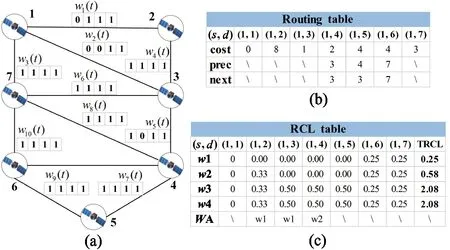
Fig.4 A simple network topology with routing table and RCL table at satellite 1
2.2 Procedure of CL-DRWA
The pseudo code of CL-DRWA is shown in Fig.5. CL-DRWA is composed of routing table updating, RCL table updating and request arrival. At First, the routing table updating process is carried out periodically by using BF algorithm, which can renew the routing table on each satellite according to the real-time status of the optical satellite network. Then RCL table updating procedure is implemented cyclically using the DRCL algorithm, leading to refreshing the RCL table with the wavelength usage status of the network. Eventually, when the connection request reaches the source satellite, the routing table will be looked up to get the route and the RCL table will be checked to assign the wavelength. Therefore, a light path is set up for the connection request. This process will be repeated until reaching the maximum simulation time.
2.2.1 Routing table updating
Assuming linkij(t) is the link connected state at time t from i to j, if the link at time t from i to j is connected, then linkij(t)=1; otherwise linkij(t)=0. When the renewal period of routing table updating is up, the operation is as follows: for each link which satisfies linkij(t)=1, TDij(t) is calculated by Eq.(3), as well as |Δλij(t)|. costij(t) is computed by Eq.(2). And then the routing table on each satellite is initialized. Next, the BF algorithm is implemented to find an optimal path for every satellite s from itself to the other satellites in the optical satellite network. Nsis the set of neighboring satellites for every satellite s. Each satellite receives the routing table from its neighboring satellites and refreshes its routing table and this will be repeated until reaching the iteration times.
2.2.2 RCL table updating
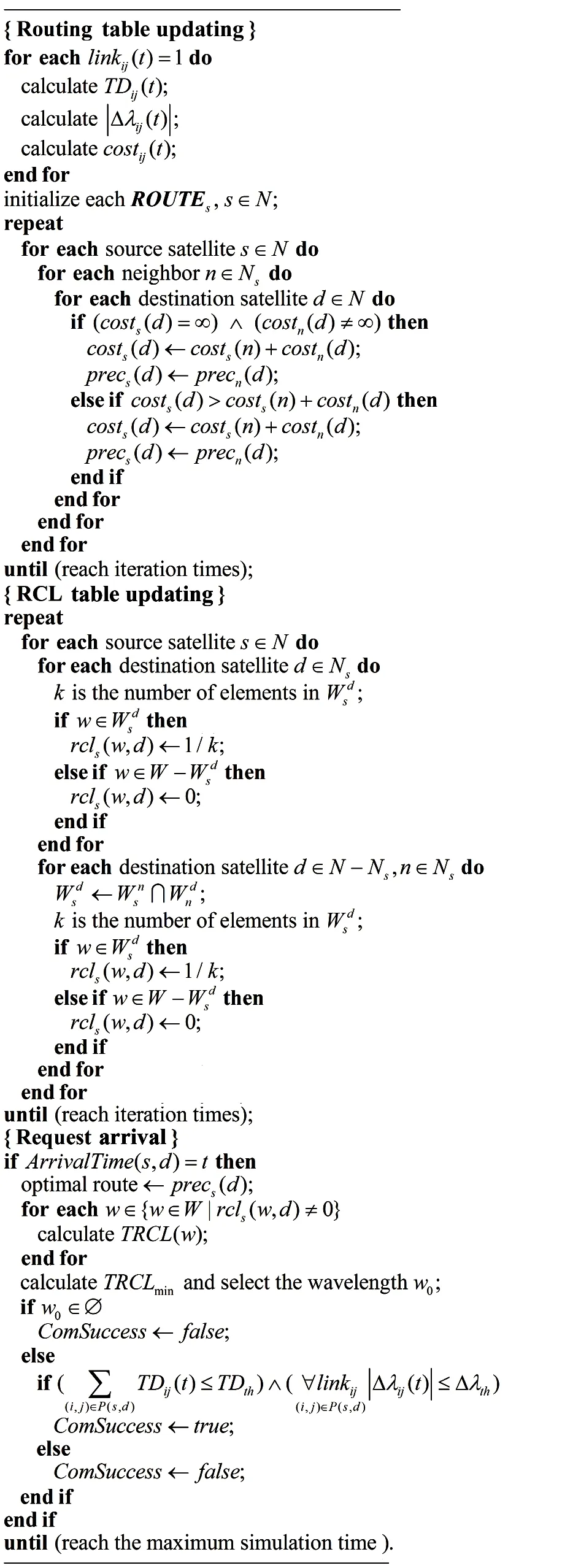
Fig.5 The pseudo code of CL-DRWA
2.2.3 Request arrival
When a connection request from satellite s to satellite d arrives at time t, the routing table on satellite s is checked and the optimal route can be derived from precs(d). Subsequently, the RCL table on satellite s is looked up. TRCL on each available wavelength is computed by summing the RCL values for each wavelength over all destinations excluding destination d, and then wavelength w0will be selected, which has the minimum TRCL. Ultimately, data transmission begins. If the wavelength of each ISL on the optimal light path is available, and the transmission delay and Doppler wavelength shift of each ISL on the optimal light path satisfy the constraints in Eq.(1), then the flag ComSuccess is set to true; otherwise it is set to false. ComSuccess means that a reliable communication is set up between source and destination.
3 Simulation results
In this section, an Iridium-like satellite constellation is considered for our study, which is expressed by using a Walker notation of 86°: 66/6/0. There are two intraorbit ISLs and two interorbit ISLs. Intraorbit ISLs are maintained permanently throughout the orbital movement of the satellites, while interorbit ISLs are broken as satellites come close to the poles (Latitude>60°) due to adverse pointing and tracking conditions, when satellites move to lower latitudes, interorbit ISLs are re-established. Moreover, cross-seam ISLs, namely links between satellites in counter-rotating orbits, are not used[21]. The number of wavelengths on each optical ISL is 16. All the wavelength routing have the same processing delay PRDij, which is set to 10ms[3]. The transmission threshold TDthis 300ms[18]. As the sources and destinations are generated randomly, all the results are obtained by statistical averaging. In the following subsections, the Doppler wavelength shift threshold is given through simulation firstly. Then the performance of CL-DRWA is simulated and analyzed.
3.1 Doppler wavelength shift threshold
Ignoring the background light power and supposing that the receiving detector is thermal noise limit, as in Ref.[15], the BER of optical communications using an on-off keying (OOK) modulation format is

(7)
here, SNR is the signal-to-noise ratio and ε is the ratio of signal power PSto crosstalk power PCT. They can be described by
(8)

(9)


(10)

(11)
where, Δf denotes Doppler frequency shift, Pris the mean receiving power of the signal, Bsis 3dB bandwidth of the laser, fLcrepresents central frequency of the laser. And Bfis 3dB bandwidth of the filter, fDexmeans central frequency of the filter.
Suppose c represents the velocity of light. The relationship between Doppler wavelength shift Δλ and Doppler frequency shift Δf is

(12)
f0=fLc=fDex=193.55THz (1550nm), fd=200GHz and Bf=2Bs=20GHz are taken. The variation of BER with Doppler wavelength shift is shown in Fig.6. It can be seen from the relationship between BER and Doppler wavelength shift that the more wavelength shift Doppler-effect induced, the more rapidly BER increases. For the inter-satellite communication systems, BER is usually up to a magnitude of 10-7[22], that is, BER must satisfy BER<1×10-6, so the BER threshold BERthis 1×10-6. According to Fig.6, the Doppler wavelength shift threshold Δλthcan be obtained, which is 3.22×10-11m.

Fig.6 Variation of BER with Doppler wavelength shift
3.2 Performance analysis of CL-DRWA
In the simulation, in order to compare CL-DRWA results, the dynamic routing and wavelength assignment algorithm based on minimum delay strategy (MD-DRWA) is used throughout the simulation. Before simulation, several definitions are given. The traffic intensity is the product of the number of wavelength channels occupied per hour in the network and the average time for each occupation[8].The communication success probability is defined as the ratio of the number of the established light paths, which satisfy the demands of transmission delay and BER in Eq.(1), to the number of total connection requests.
The effect of weighted values in the cost expression of CL-DRWA is illustrated in Fig.7, where weight ωdand ωware varied from 0.9 to 0.1 and communication success probability as a function of traffic intensity is captured. The results show that the ratio of the weighted values greatly affects the communication success probability. It can be seen that, when ωdtakes the value of 0.9, 0.8 and 0.7, the changing trend of the curves is basically the same in these three cases and the communication success probability is about 90%. The communication probability degrades when ωdvaries from 0.4 to 0.1, and the curves have a rapid downward trend with the increase of the traffic intensity. The reason is that, the larger the value of ωw, the larger the probability to choose the interorbit ISLs with small Doppler wavelength shift, which causes no available wavelength resources at these interorbit ISLs and makes the request blocked. What’s more, the communication success probability can reach about 94% as the value of ωdis 0.6. And when the value of ωdis equal to the value of ωw(0.5), the communication success probability is about 95% and the performance of the algorithm is the best. This is because, when setting up a light path, the link cost caused by the transmission delay in Eq.(2) makes the route not too long, meanwhile, the link cost caused by the Doppler wavelength shift in Eq.(2) have a good effect on avoiding the ISL which has a large Doppler shift. When the values of ωdand ωwhave little difference, it can achieve a better tradeoff between the transmission delay and the Doppler wavelength shift, and make a high probability of the established light path to satisfy the constraints in Eq.(1).
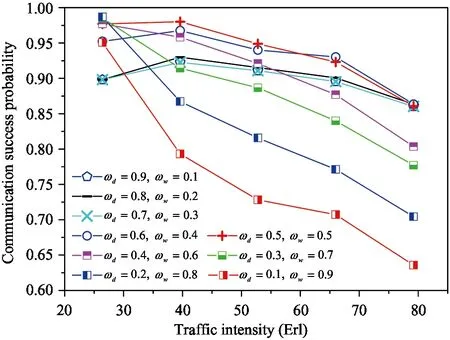
Fig.7 The communication success probability of various ratios of weighted values in CL-DRWA
Fig.8 is the communication success probability for both MD-DRWA and CL-DRWA. In CL-DRWA, ωdand ωwboth take the value of 0.5. It can be clearly seen that as the traffic intensity increases, the communication success probability of the two algorithms are going down slowly, due to the growth of the wavelength resource utilization. Moreover, the communication success probability of CL-DRWA is higher than that of MD-DRWA and the growth increment is 5.3%. Table 1 illustrates the simulation data on the communication success probability of different algorithms so as to make the growth increment more clear. The growth increment (%) is the percentage of the communication success probability of CL-DRWA higher than that of MD-DRWA in the case of each traffic intensity. The average value of the growth increment is taken, which is equal to 5.3%. The reason is that CL-DRWA reduces the possibility to select the interorbit ISLs which has a large Doppler shift and makes a high probability of the established light path to satisfy the constraints in Eq.(1). Furthermore, CL-DRWA enriches the choices of light path, so wavelength resource usage is balanced.
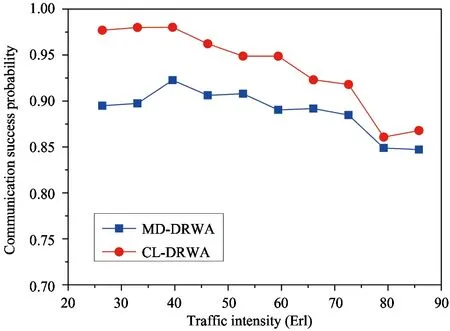
Fig.8 The communication success probability of different algorithms
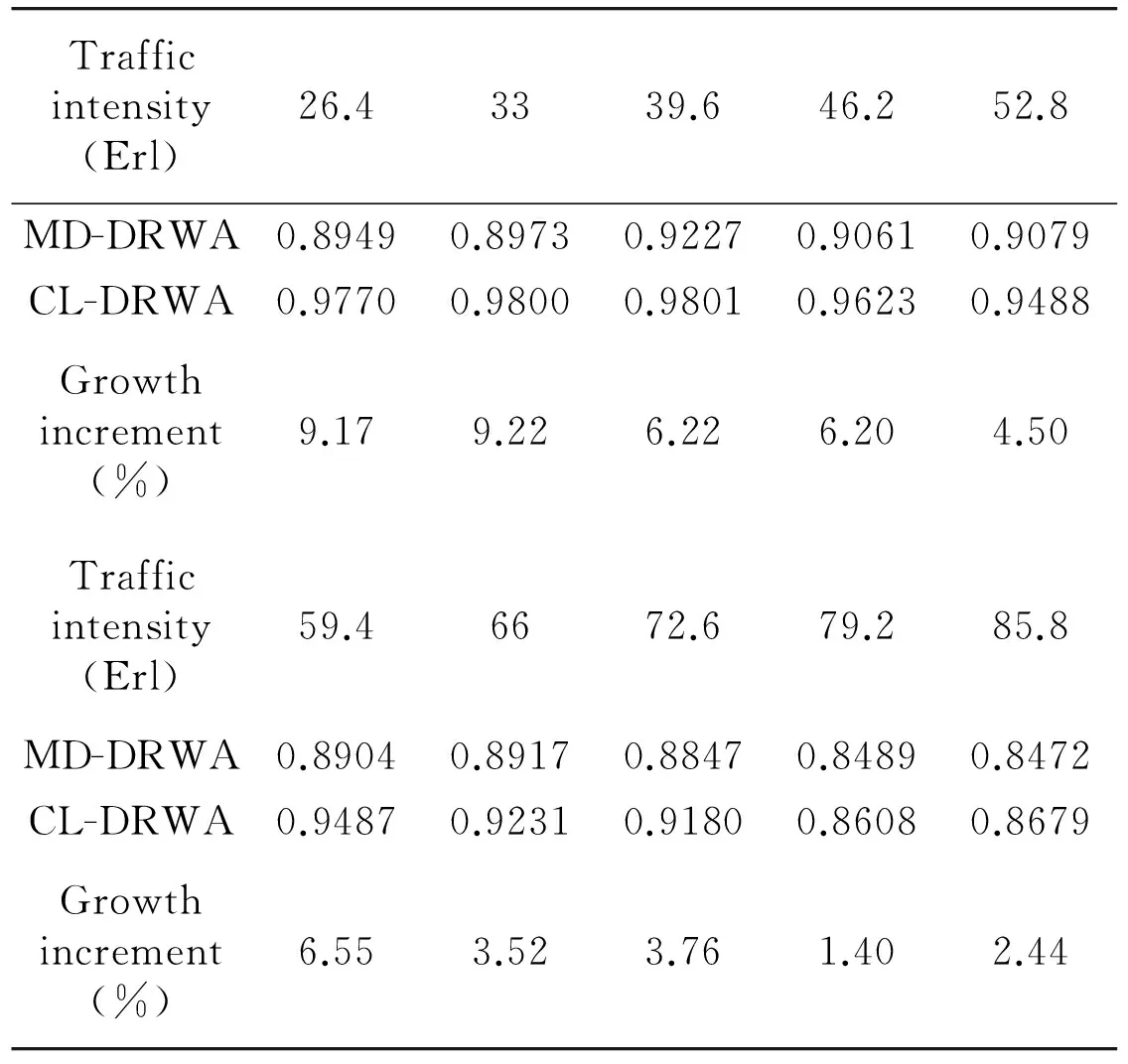
Trafficintensity(Erl)26.43339.646.252.8MD-DRWA0.89490.89730.92270.90610.9079CL-DRWA0.97700.98000.98010.96230.9488Growthincrement(%)9.179.226.226.204.50Trafficintensity(Erl)59.46672.679.285.8MD-DRWA0.89040.89170.88470.84890.8472CL-DRWA0.94870.92310.91800.86080.8679Growthincrement(%)6.553.523.761.402.44
Fig.9 shows the transmission delay performance as a function of traffic intensity when MD-DRWA and CL-DRWA are utilized in the network respectively. In CL-DRWA, ωdand ωwhave the value of 0.5. It can be seen clearly from these two plots that there is a gap between the two algorithms with the increasing traffic intensity, but the gap is small. The reason is that, CL-DRWA can avoid selecting the interorbit ISLs which has a large Doppler shift, leading to an increase of the number of hops of the route, but the transmission delay constraint of CL-DRWA limits the number of hops not to be too large. As shown in Fig.9, operating CL-DRWA in the network increases the transmission delay, but the delay is basically stable at around 160ms, which can meet the needs of real-time traffic transmission[23].s
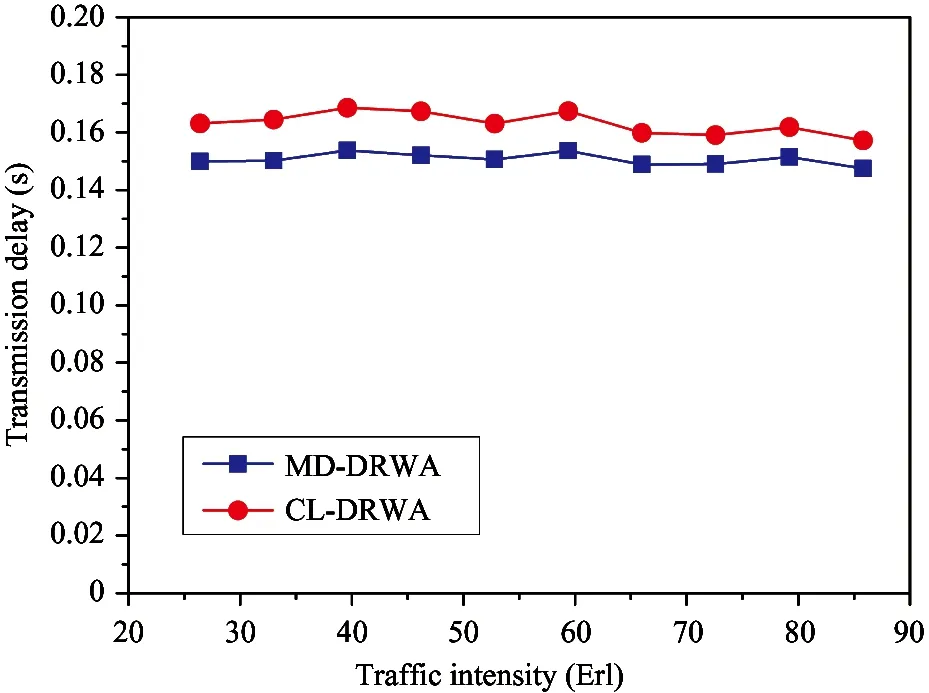
Fig.9 The transmission delay of different algorithms
4 Conclusions
In this paper, CL-DRWA is put forward for the sake of improving the robustness of the optical satellite networks. Since Doppler wavelength shift has a negative impact on the quality of communication, a cross-layer optimization model is designed, which takes into account not only the constraints of the maximum transmission delay and Doppler wavelength shift the optical satellite networks can tolerant but also the wavelength continuity. In consideration of the dynamic state changes of the satellite network, CL-DRWA is used to solve the cross-layer optimization model, bringing about an optimal light path which satisfies the above constraints for every connection request. In setting up a light path, BF is used to find an optimal route and DRCL algorithm is implemented to get an optimal wavelength assignment result on the optimal route. The performance of CL-DRWA has been evaluated through extensive simulations with very promising results. Firstly, the effect of weighted values in the cost functions of CL-DRWA is analyzed. When the value of ωdis equal to that of ωw, the performance of the proposed algorithm is optimal as a result of a better tradeoff between the transmission delay and the Doppler wavelength shift. Furthermore, compared with MD-DRWA, CL-DRWA can enhance the communication success probability by about 5.3%. Meanwhile, CL-DRWA can meet the requirement of transmission delay for real-time services. These works contribute to the design of wavelength routing strategy with consideration of the Doppler wavelength shift factor in the WDM optical satellite networks.
Reference
[ 1] Karafolas N, Baroni S. Optical satellite networks. Journal of Lightwave Technology, 2000, 18(12): 1792-1806
[ 2] Chan V W S. Free-space optical communications. Journal of Lightwave Technology, 2006, 24(12): 4750-4762
[ 3] Tan L, Yang Q, Ma J, et al. Wavelength dimensioning of optical transport networks over nongeosychronous satellite constellations. Journal of Optical Communications and Networking, 2010, 2(4): 166-174
[ 4] Kazemlou S, Hranilovic S, Kumar S. All-optical multihop free-space optical communication systems. Journal of Lightwave Technology, 2011, 29(18): 2663-2669
[ 5] Karimi M, Nasiri-Kenari M. Free space optical communications via optical amplify-and-forward relaying. Journal of Lightwave Technology, 2011, 29(2): 242-248
[ 6] Rabinovich W S, Moore C I, Mahon R, et al. Free-space optical communications research and demonstrations at the US Naval Research Laboratory. Applied Optics, 2015, 54(31): 189-200
[ 7] Liu B, Xin X, Zhang L, et al. A WDM-OFDM-PON architecture with centralized lightwave and PolSK-modulated multicast overlay. Optics express, 2010, 18(3): 2137-2143
[ 8] Dong Y, Zhao S, dan Ran H, et al. Routing and wavelength assignment in a satellite optical network based on ant colony optimization with the small window strategy. Journal of Optical Communications and Networking, 2015, 7(10): 995-1000
[ 9] Zang H, Jue J P, Mukherjee B. A review of routing and wavelength assignment approaches for wavelength-routed optical WDM networks. Optical Networks Magazine, 2000, 1(1): 47-60
[10] Yang Q, Tan L, Ma J, et al. An analytic method of dimensioning required wavelengths for optical WDM satellite networks. IEEE Communications Letters, 2011, 2(15): 247-249
[11] Dong T, and Shen G. Traffic grooming for IP over WDM optical satellite networks. In: Proceedings of the 13th International Conference on Optical Communications and Networks (ICOCN 2014), Suzhou, China, 2014. 1-6
[12] Guo Y, Wang D, Liu F. Research on routing and wavelength/subcarrier assignment algorithm based on layered-graph model in optical satellite networks. In: Proceedings of the 5th International Conference on Optical Communication Systems (OPTICS 2014), Vienna, Austria, 2014. 69-76
[13] Liu Z, Guo W, Deng C, et al. Wavelength dimensioning for wavelength-routed WDM satellite network. Chinese Journal of Aeronautics, 2016, 29(3): 763-771
[14] Yang Q, Tan L, Ma J. Doppler characterization of laser inter-satellite links for optical LEO satellite constellations. Optics Communications, 2009, 282(17): 3547-3552
[15] Yang Q, Tan L, Ma J. Analysis of Doppler-effect on satellite constellations with wavelength division multiplexing architectures. Chinese Optics Letters, 2009, 7(1): 19-22
[16] Pratt S R, Raines R A, Fossa Jr C E, et al. An operational and performance overview of the IRIDIUM low earth orbit satellite system. Communications Surveys, 1999, 2(2): 2-10
[17] Suzuki R, Yasuda Y. Study on ISL network structure in LEO satellite communication systems. Acta Astronautica, 2007, 61(7): 648-658
[18] Wang H, Zhang Q, Xin X, et al. Cross-layer design and ant-colony optimization based routing algorithm for low earth orbit satellite networks. China Communications, 2013, 10(10): 37-46
[19] ITU-T Study Group 12. ITU-T Recommendation G.1010: End-user multimedia QoS categories. Switzerland: Telecommunication Standardization Sector of ITU, 2001
[20] Srivastava V, Motani M. Cross-layer design: a survey and the road ahead. IEEE Communications Magazine, 2005, 43(12): 112-119
[21] Wang H, Zhang Q, Xin X, et al. A multi-path routing algorithm of LEO satellite networks based on an improved ant colony system. High Technology Letters, 2014, 20(3): 253-260
[22] Jiang H L, Tong S F, Zhang L Z, et al. The Technologies and Systems of Space Laser Communication. Beijing: National Defense Industry Press, 2010. 74-76 (In Chinese)
[23] Yu B, Chen P, Zhang Z. The realization and performance research of MCU in videoconferencing system. Communications Technology, 2001, 7: 17-19
her B.S. degree in Information Engineering from Beijing University of Posts and Telecommunications (BUPT), China in 2012. She is currently pursuing her Ph.D of Electronic Science and Technology in BUPT. Her research interests include routing and resource management in the optical satellite networks.
10.3772/j.issn.1006-6748.2017.03.004
Supported by the National Natural Science Foundation of China (No. 61675033, 61575026, 61675232, 61571440) and the National High Technology Research and Development Program of China (No. 2015AA015504).
To whom correspondence should be addressed. E-mail: zhangqi@bupt.edu.cn
on Sep. 7, 2016
杂志排行
High Technology Letters的其它文章
- Quantitative analysis of the performance of vector tracking algorithms①
- Application of linear active disturbance rejection control for photoelectric tracking system①
- Structure design of gradient hard coatings on YG8 and their residual stress analysis by ANSYS①
- ZnO whiskers growth on the surface of Sn9Zn/Cu solder joints in concentrator silicon solar cells solder layer①
- Characterizing big data analytics workloads on POWER8 SMT processors①
- A leveling mechanism for the platform based on booms-constraint control of aerial vehicle①
